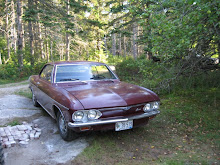Over the decades Detroit manufacturers have worked with the following equation: large cars = great cars, small cars = cheap cars. So no one really engineered or marketed a small car to be a great car.
Well, actually, by accident, Chevrolet did when they created my beloved Corvair. Without realizing it they made the Corvair a far better car - unibody, low stressed air cooled engine, superb styling in either early or late guise, great seating capacity - than other "compacts." But at the same time, they sought to sell it on low price alone. So the interiors were cheezy, a passenger side sun visor and heater were optional, marketing was aimed at economy, build quality in the later models was appalling, even by '60's standards, and so on.
But European manufacturers long ago recognized that the laws of physics affect automobiles, too. So why not make an elegant, superbly designed small car? They used the registration and tax laws to their advantage. If gas taxes are quite high [now about $3.80 per gallon according to the Boston Globe], why not make engines fuel efficient? Why not make 4-5-6 speed transmissions so those same engines can propel the cars to autobahn speeds? Since they'll be going much faster than Americans do on their highways, we'd better give them great suspensions and handling packages. And Europeans are less likely to own multiple cars so they made them with higher quality so they would last.
The European models that could not make it in the US were the Renault Dauphines and Fiat 500's, the economy cars with tiny engines [<1>
Subscribe to:
Post Comments (Atom)








No comments:
Post a Comment